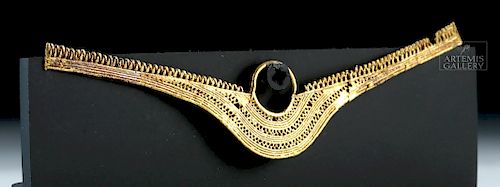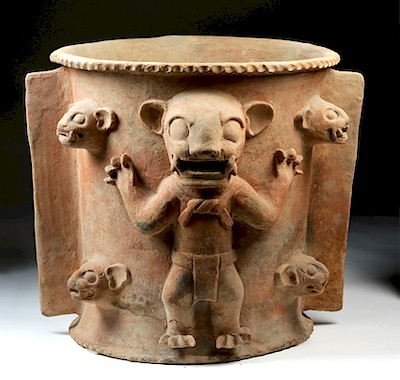Delicate Sinu 20 K Gold Elongated Nose / Earring - 1.8g
Lot 171d
About Seller
Artemis Fine Arts
686 S Taylor Ave, Ste 106
Louisville, CO 80027
United States
Selling antiquities, ancient and ethnographic art online since 1993, Artemis Gallery specializes in Classical Antiquities (Egyptian, Greek, Roman, Near Eastern), Asian, Pre-Columbian, African / Tribal / Oceanographic art. Our extensive inventory includes pottery, stone, metal, wood, glass and textil...Read more
Estimate:
$700 - $1,200
Absentee vs Live bid
Two ways to bid:
- Leave a max absentee bid and the platform will bid on your behalf up to your maximum bid during the live auction.
- Bid live during the auction and your bids will be submitted real-time to the auctioneer.
Bid Increments
| Price | Bid Increment |
|---|---|
| $0 | $25 |
| $300 | $50 |
| $1,000 | $100 |
| $2,000 | $250 |
| $5,000 | $500 |
| $10,000 | $1,000 |
| $20,000 | $2,500 |
| $50,000 | $5,000 |
| $100,000 | $10,000 |
| $200,000 | $20,000 |
About Auction
By Artemis Fine Arts
Dec 6, 2018
Set Reminder
2018-12-06 10:00:00
2018-12-06 10:00:00
America/New_York
Bidsquare
Bidsquare : DAY 2 : Pre-Columbian, Ethnographic & Fine Art
https://www.bidsquare.com/auctions/artemis-gallery/day-2-pre-columbian-ethnographic-fine-art-3699
Day 2 of an important 2-dy auction featuring ancient and ethnographic art from around the world. Today's sale will feature Pre-Columbian, Native American, African / Tribal, Ethnographic, Spanish Colonial, Fine Art, much more. Artemis Fine Arts info@artemisgallery.com
Day 2 of an important 2-dy auction featuring ancient and ethnographic art from around the world. Today's sale will feature Pre-Columbian, Native American, African / Tribal, Ethnographic, Spanish Colonial, Fine Art, much more. Artemis Fine Arts info@artemisgallery.com
- Lot Description
**First Time At Auction**
Pre-Columbian, Colombia, Sinu, ca. 800 to 1500 CE. Finely crafted from 20 karat gold, this elongated, crescent-shaped earring was cast via the lost wax (cire perdue) process by the Sinu culture which inhabited the hills and valleys of the middle Cauca River during the centuries prior to Spanish conquest in the 1530s. The earring has an intricate composition of two filigreed, delicate, lacelike openwork woven motifs, separated by striated bands. A golden fringe runs along the top, interrupted at the center by a suspension ring. Size: 3.75" W x 0.75" H (9.5 cm x 1.9 cm); 1.5" H (3.8 cm) on included custom stand; 20 karat gold (83% Au), 1.8 grams.
Similar examples have been written about by Heidi King of the Metropolitan Museum of Art in "The Art of Precolumbian Gold." King writes, "Ear ornaments are ubiquitous in the personal jewelry of ancient America. South American peoples were especially fond of their use, and, for millennia, they made the ornaments in an enormous variety of pattern, size, and material. Many of the shapes and sizes of these ornaments are so extraordinary that to people of twentieth-century sensibility they seem unwearable. That is not the case . . . The delicate wire work of which they are composed gives the ornaments a light and graceful aspect of great appeal. Indeed they were much admired in ancient times too, for this type of ornament was made in some quantity." This example could be fitted with a modern catch in order to be worn - or put onto a chain to be worn as a pendant.
Provenance: private southern California, USA collection, acquired in the 1970s to mid-1980s
All items legal to buy/sell under U.S. Statute covering cultural patrimony Code 2600, CHAPTER 14, and are guaranteed to be as described or your money back.
A Certificate of Authenticity will accompany all winning bids.
We ship worldwide and handle all shipping in-house for your convenience.
#141032Very slight bending to form. One area along one of the arms that looks like a tiny casting error. Small loss to fringe on the top of the same arm.Condition
- Shipping Info
-
All shipping is handled in-house for your convenience. Your invoice from Artemis Gallery will include shipping calculation instructions. If in doubt, please inquire BEFORE bidding for estimated shipping costs for individual items.
-
- Buyer's Premium



 EUR
EUR CAD
CAD AUD
AUD GBP
GBP MXN
MXN HKD
HKD CNY
CNY MYR
MYR SEK
SEK SGD
SGD CHF
CHF THB
THB













